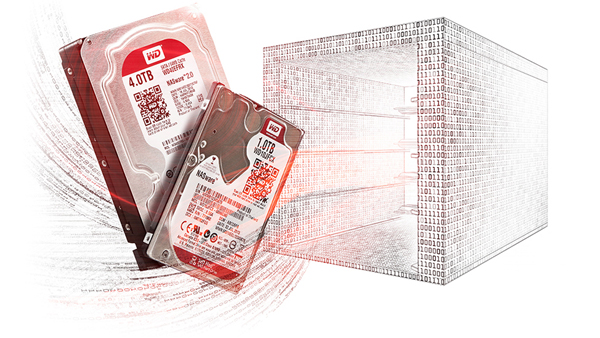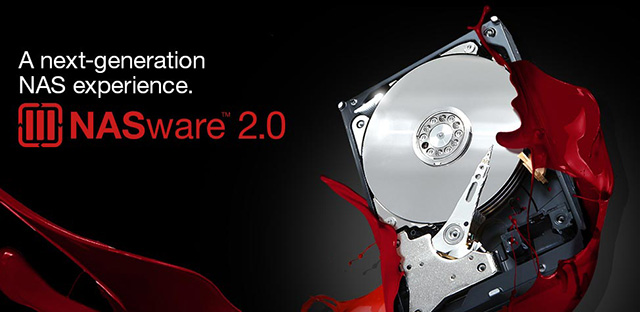
WD Red Hardware Enhancements
Physically, the WD Red family of hard disk drives is almost identical to the WD Green family of low-powered desktop hard disk drives. Probably the main physical difference would be the inclusion of 3D Active Balance Plus, which Western Digital touts as an "enhanced dual-plane balance control technology".
The mechanism by which this is achieved is not known, but what's known is that it reduces the amount of vibration produced by the WD Red hard disk drive. This not only improves the reliability of the WD Red drive itself, but also other drives in the NAS system. It also has the beneficial side effect of making the drive slightly quieter, shaving off a decibel or so.
Thanks to 3D Active Balance Plus, up to five WD Red hard disk drives can be used in a single NAS unit. If your NAS enclosure supports more than five hard disk drives, then Western Digital recommends using their Se family of drives. The WD Se drives feature even more advanced vibration control technologies, like StableTrac and Enhanced RAFF (Rotary Acceleration Feed Forward) technology, allowing 6 or more drives to be safely used in a single NAS unit.
 Western Digital also reduced the power consumption of the WD Red drive, not just by spinning at a slower spindle speed. The 4 TB WD Red hard disk drive uses just 4.5 watts of power during reads and writes, while the roughly equivalent 4 TB Western Digital Re (WD4000FYYZ) uses 10.4 watts. Even when they both idle, the high performance Re drive uses 5.3 watts more power than the Red drive.
Western Digital also reduced the power consumption of the WD Red drive, not just by spinning at a slower spindle speed. The 4 TB WD Red hard disk drive uses just 4.5 watts of power during reads and writes, while the roughly equivalent 4 TB Western Digital Re (WD4000FYYZ) uses 10.4 watts. Even when they both idle, the high performance Re drive uses 5.3 watts more power than the Red drive.
This is at least partly due to the higher areal density platters used. Thanks to Advanced Format, the WD40EFRX uses only three platters - each with an astounding storage capacity of 1 TB! The 4 TB Western Digital Re, in comparison, which needed to use 5 platters because it didn't support Advanced Format. The fewer platters to spin, the lower the drive's power consumption.
The lower power consumption is important because it means the drive produces less heat. With so many drives stacked together in the enclosure, a lower thermal output would increase the drives' reliability. In the FLIR comparison on the right, they demonstrated how much cooler the WD Red drive is, compared to an unidentified competitor's hard disk drive. However, it is not known if the competing drive is a 5400 RPM or a 7200 RPM hard disk drive.
The lower thermal output also allows the WD Red drive to work in hotter conditions. While the Caviar Green drives are rated to work at ambient temperatures of up to 60 °C, the WD Red drives can work at a higher ambient temperature of up to 70 °C.
Finally, WD Red drives undergo more rigorous factory qualification tests, allowing Western Digital to give them a MTBF rating of 1,000,000 hours, which is a 35% improvement over regular desktop hard disk drives. To give you an idea of what that means, a NAS system with 5 Red drives will likely see a single drive failure after 22.8 years of non-stop operation.

Western Digital NASware 2.0
The WD Red's main advantage lies in its NASware firmware, which Western Digital has upgraded to version 2.0 for the new 4 TB model. This is how the new NASware 2.0 firmware helps the WD Red differentiate itself from standard desktop hard disk drives :
-
Compatibility - NASware 2.0 has been extensively tested with key small NAS system providers.
-
Streaming support - NASware 2.0 provides built-in compatibility with the ATA Streaming Feature Set which is important for AV storage applications such as Windows Media Center
-
SMART Command Transport (SCT) support - NASware 2.0 allows monitoring and measuring of drive performance via the SMART command set. SMART can return data like thermal profiles, drive access statistics and more. NASware 2.0 also delivers temperature accuracy within 1°C.
-
Power management support - Enables optimized power usage within the NAS system and protects your data in the event of a power loss or disruption.
-
Lower power consumption - NASware 2.0 optimizes power use resulting in significant power savings and lower hard drive operating temperatures. This improves the overall reliability and performance of the drive and reduces the NAS cost of ownership.
-
BIC Performance - Optimized seek to provide BIC performance while reducing the power and acoustics.
-
RAID-specific, time-limited error recovery (TLER) - NASware 2.0 also prevents hard drives from being dropped off the RAID due to extended error recovery. This provides more availability and less down time rebuilding the RAID.
-
Command completion - To further improve reliability, NASware 2.0 minimizes the data corruption or loss in the event of an unexpected power loss by completing the command in process before shutting down.
TLER Support
All modern hard disk drives are designed to automatically correct read and write errors and protect against further data corruption by remapping bad sectors with spare sectors. This remapping process can take anywhere from a few seconds to several minutes to accomplish, depending on the number of bad sectors and the drive's workload.
Unfortunately, RAID controllers are designed to drop hard disk drives from a RAID array if they are unresponsive for more than a few seconds. This is done in the assumption that such a drive has either malfunctioned or is no longer reliable. Depending on the type of RAID array, it can cause the array to lose its data redundancy or force a rebuild of the RAID array from parity data.
To prevent this, the Western Digital Red supports TLER, which is short for Time-Limited Error Recovery. It limits the read error recovery process in the Red to just 7 seconds, after which the error recovery process is aborted. This prevents the RAID controller from marking the drive as unreliable and dropping it from the RAID array. The RAID controller can also take over whatever error recovery is left to perform.
You can modify thus default setting using the Western Digital Time Limit Error Recovery Utility (WDTLER.EXE). Many RAID controllers have timeout delays that are longer than 7 seconds, and it is recommended that TLER be delayed for as long as possible. As long as TLER is set to timeout at least 1 second before the RAID controller times out, it will prevent the RAID controller from dropping the drive.
TLER has no performance implications when used outside of RAID arrays. However, it prevents the error recovery process from completing and because there is no RAID controller to take over the error recovery process, detected bad sectors may not be replaced in time. Therefore, it is not advisable to use TLER-enabled drives in non-RAID situations. You can, of course, solve the problem by turning off TLER.
| If you like this article, please share it! -> |
Support Tech ARP!
If you like our work, you can help support out work by visiting our sponsors, participate in the Tech ARP Forums, or even donate to our fund. Any help you can render is greatly appreciated!
Page |
Topic |
|
1 |
||
2 |
||
3 |
||
4 |
||
5 |
• Testing The 4 TB Western Digital Red |
|
6 |
• Transfer Rate Range, Platter Profile |
|
7 |
||
8 |
||
9 |
||
10 |
<<< The 4 TB Western Digital Red, Peeking Under The PCB : Previous Page | Next Page : Testing The 4 TB Western Digital Red, Usable Capacity, Maximum Temperature >>>
Support us by buying from Amazon.com! |
|
| Grab a FREE 30-day trial of Amazon Prime for free shipping, instant access to 40,000 movies and TV episodes and the Kindle Owners' Lending Library! | |







 Add to Reddit
Add to Reddit
